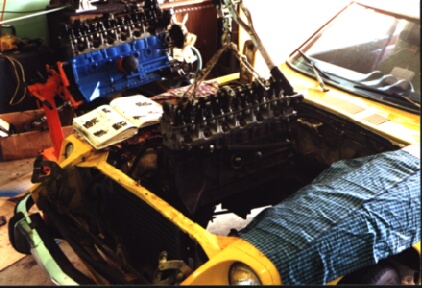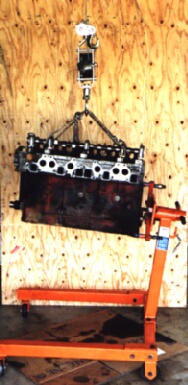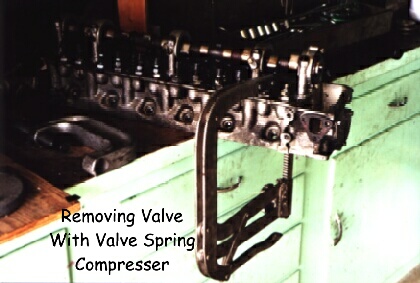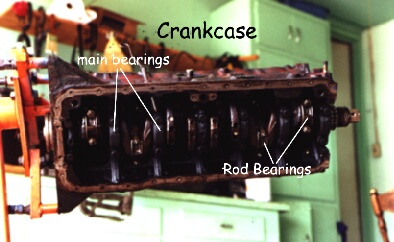 1.
Go to Dissasembly
1.
Go to Dissasembly
After about 200,000 miles, a 240Z usually requires an engine rebuild. Actually,
most of the major components such as the cylinder walls and main bearings will
hardly be worn and probably meet specifications. However, compression readings
for cylinders may become uneven and oil consumption past valve stem seals often
begins. There may be some embarrassing blue smoke off the line. Oil pressure may
be almost nonexistent idling on a hot day. Several times I have also experienced
white (coolant) smoke from a head crack or bad head gasket. The good news is
these engines are surprisingly easy and inexpensive to make young again.
This description of rebuilding a Datsun 240Z L24 engine focuses on the simple
tasks of replacing rings, seals and bearings in the block. While you are
rebuilding the block, the cylinder head should be taken to a machine shop for a
professional rebuild or at least replacement of the rubber valve stem seals.
The Datsun 240Z L24 engine is a relatively easy to pull, disassemble, inspect,
repair and install. A complete basic metric tool set plus a few specialty tools
will allow you to do most of the job yourself. An original Datsun shop manual
(out of print) or a good aftermarket manual such as a Haynes manual is critical
to successfully rebuilding the L24.
Dissasembly. Run diagnostic tests such as
compression tests, coolant leak tests and combustion chamber leak down tests
before you destroy the evidence by tearing down the engine. Clean the dirty
grease off the outside of the engine before you start. This will help keep
disassembled parts clean and allow you to spray paint the block while it is out
of the engine compartment.
An engine rebuild is easy to start. Unhook all the hoses, linkages and wires
between the engine and car body. But wait! Have you ever seen a "basket
case" engine or motorcycle torn apart by some clod who forgot how to put it
back together? Use the shop manual. Place the screws, nuts and other parts into
labeled plastic sandwich bags as you go.
Make room in the engine compartment by removing the radiator, air filter housing
and exhaust pipe. Remove the alternator and starter motor. Support the
transmission on wood blocks, a dolly or transmission jack (things will go easier
if your transmission support has wheels). Remove the 4 bolts that hold the
engine block and transmission together. (Later, you can view the clutch
components and consider replacement of the clutch disk, throwout bearing and
pressure plate.)
 Pulling the Engine. If you don't have a
wheeled "cherry picker" to pull the engine, attach a 2 ton "come
along" (tool 1 below) hand wench to your garage rafters to lift the engine.
You should run an extra 4x4 along side one of the rafter beams for a strong lift
point. In 2-car garages, the span is greater so a strong 2x12 beam should be
mounted on end across the rafter beams. Extra metal braces should be added to
strengthen corners and joints. You don't want the triumphant moment of pulling
the engine spoiled as your ceiling falls in and the engine crashes back into
your beautiful Z.
Pulling the Engine. If you don't have a
wheeled "cherry picker" to pull the engine, attach a 2 ton "come
along" (tool 1 below) hand wench to your garage rafters to lift the engine.
You should run an extra 4x4 along side one of the rafter beams for a strong lift
point. In 2-car garages, the span is greater so a strong 2x12 beam should be
mounted on end across the rafter beams. Extra metal braces should be added to
strengthen corners and joints. You don't want the triumphant moment of pulling
the engine spoiled as your ceiling falls in and the engine crashes back into
your beautiful Z.
Remove the clutch pressure plate and fly wheel. With the engine suspended from
the rafters, it can easily be mounted to a movable engine stand ($50 and up). An
engine stand allows you move and pivot the engine around as you rebuild the
block. Remove the crank shaft pulley (a wheel puller is required), front case,
cam gear and cam chain. Mark the orientation of the gears and chain to simplify
reassembly. Remove the head bolts (10 mm allen socket) and pull off the head.
Inspection. A quick visual inspection of
the combustion chamber will tell you a lot about the condition of the engine.
Oil in a cylinder, from worn valve guides or piston rings, will leave an oily
black crust. Coolant entering a combustion chamber through a blown head gasket
or cracked head will leave it cleaned of the crusty deposits found in the other
combustion chambers. Burned valves, burnt pistons and thrown rods leave deep
scratches, obvious cracks and molten metal.
 Inspection
for normal wear requires a set of several specialized measuring devices. Check
the block and head surfaces for flatness using a good straight edge. A 1-inch
micrometer is useful to check diameter, taper and roundness of valve stems. A
2-inch micrometer is needed to measure crank journals (shaft bearing surface)
diameter. A 4-inch micrometer (tool 2 right) is used to measure piston
dimensions. A cylinder micrometer (tool 2 up) is slid into the cylinders to
check diameter, taper and roundness. With piston rings placed squarely in the
cylinders, piston ring gaps are checked with standard feeler gages. Rod bearing
and main bearing clearances can be checked with "Plastigages".
Plastigages are wax wires to place on a bearing surface before torquing the
bearing cap in place. When the bearing cap is removed, the Plastigage wax wires
have been squished - tight bearings squish them flat and wide, worn bearings
barely flatten the plastigage. The bearing clearance is read by comparing the
squished Plastigage width to a supplied chart.
Inspection
for normal wear requires a set of several specialized measuring devices. Check
the block and head surfaces for flatness using a good straight edge. A 1-inch
micrometer is useful to check diameter, taper and roundness of valve stems. A
2-inch micrometer is needed to measure crank journals (shaft bearing surface)
diameter. A 4-inch micrometer (tool 2 right) is used to measure piston
dimensions. A cylinder micrometer (tool 2 up) is slid into the cylinders to
check diameter, taper and roundness. With piston rings placed squarely in the
cylinders, piston ring gaps are checked with standard feeler gages. Rod bearing
and main bearing clearances can be checked with "Plastigages".
Plastigages are wax wires to place on a bearing surface before torquing the
bearing cap in place. When the bearing cap is removed, the Plastigage wax wires
have been squished - tight bearings squish them flat and wide, worn bearings
barely flatten the plastigage. The bearing clearance is read by comparing the
squished Plastigage width to a supplied chart.
Check your shop manual for specifications of acceptable dimensions and
clearances. If the head is flat and valves not worn, it may not need machining
by a professional shop but the rubber valve stem seals should be replaced (see
valve removal illustration below). Piston rings and crankshaft bearings should
be replaced since they are very cheap and easy to install. If the engine
"blew up" or is excessively worn, the block should be brought to a
machine shop for necessary repairs such as boring the cylinders or turning the
crank shaft on a lathe.
 Replacing
Engine Components. Rod bearings, main bearings, crank shaft oil
seals and piston rings are inexpensive. Replace all these parts even if
inspection finds all clearances within specification. Remove the rod bearing
caps and push the pistons out through the top of the block. Take care to observe
the orientation of all block parts so they can be replaced as they were (to
help, many parts are numbered or have direction indicators).
Replacing
Engine Components. Rod bearings, main bearings, crank shaft oil
seals and piston rings are inexpensive. Replace all these parts even if
inspection finds all clearances within specification. Remove the rod bearing
caps and push the pistons out through the top of the block. Take care to observe
the orientation of all block parts so they can be replaced as they were (to
help, many parts are numbered or have direction indicators).
Rod and main bearings are composed
of two C-shaped half sections. Finger pressure on the edge of an old rod bearing
section is usually enough to slip the rod bearing half section off a piston rod
end or a rod bearing cap. Old piston rings should be removed using ring pliers
(tool 3 up). Unscrew all main bearing bolts and pull off main bearing caps. Slip
out main bearings as you did with the rod bearings. The rear main bearing cap
requires a special pulling tool to remove. However, I have pulled them by
pulling up on the crank with the overhead "come along" while I tap on
the rear main cap with a rubber mallet. With all the rod and main bearings
removed, the crank shaft can be removed for inspection and for installation of a
new rear main seal.
 Clean
all parts meticulously before installation of replacement bearings and rings.
Prelubricate all parts with engine oil plus STP before assembly.
Clean
all parts meticulously before installation of replacement bearings and rings.
Prelubricate all parts with engine oil plus STP before assembly.
Set all block-side main bearing halves in place then set the crankshaft back in
positionon top of them. Set the other main bearing halves in the main bearing
caps. Place the main bearing caps with their bearing halves over the crankshaft
main journals to complete the assembly of the block main bearings. Evenly
tighten all the main bolts to the point of contact before you torque them all to
15 ft-lb and finally to 38 ft-lb.
Use the piston ring pliers to put new rings on a piston staggering the ring end
gaps so the first and second compression ring gaps do not line up. The 3-piece
oil rings can be carefully slid into the bottom piston ring groove by hand.
Place a new rod bearing half on the piston rod. With a piston ring compressor
(tool 3 left), squeeze the piston rings firmly into their grooves. Insert the
rod and piston into the cylinder they originally came out of and with the
"F" mark on the piston facing the front of the engine. With the ring
compressor set fully flat to the block surface and tightly squeezing the rings
into their grooves, gently tap the piston into the cylinder. Be sure the rod
bearing sets into the crank shaft journal as the piston slides into the
cylinder. If the piston does not slide into the cylinder with gentle tapping, do
not force it - tap the piston ring compressor to ensure it is in flat contact
with the block and make sure the ring compressor is tight. Try again. Repeat
this process with the other five pistons.
For each piston, set and lubricate a new rod bearing half in a rod bearing cap.
Assemble the rod bearings by placing the rod bearing caps over the crankshaft
rod journals and bolt them to the previously set rods. Tighten to contact at
first then torque down to 10 ft-lb then finally torque to 24 ft-lb. Your block
is rebuilt. You will have high compression and high oil pressure for the next
100,000 miles.
Engine Reassembly. Reassemble in the
reverse order of assembly. Modern head gaskets do not require gasket cement.
Before mating the head to the block, rotate the crank shaft and cam shaft each
to the cylinder #1 top dead center position (crank and cam keyways pointing up).
Otherwise, pistons and valves may clash as the head is placed on the block.
Starting from the center head bolts and working out, tighten all the head bolts.
Finger tighten then torque all the bolts (starting again from the center) to
about 35 ft-lb and finally torque all the head bolts to 54 ft-lb. Install the
timing chain so one silver link seats next to the mating mark on the crank gear.
Install the timing chain tensioner. Hold the timing chain taut to keep the chain
tensioner in place as the second silver chain link is seated next to the mating
mark on the cam gear (42 links between mating marks). The cam gear should now
fit snugly at the end of the cam shaft with the cam peg fitting into the number
1 hole of the cam gear. Torque the camshaft gear bolt to 43 ft-lb.
Press a new front seal into the front cover. This can be done without a special
tool. Grease the seal inside and out. Place the front cover on a flat surface,
set the seal over the mounting hole with a flat board over it. Hold the board
level as you tap it with a mallet. The idea is to push the seal into the seal
mounting hole with even level force. Apply gasket cement to the scraped and
cleaned gasket surfaces of the block front and front cover. Install the front
cover to the block with gaskets in between.
Set the engine to TDC piston 1. The oil pump should be replaced, preferably with
a high output pump upgrade. Install the oil pump/distributor driving spindle and
then the oil pump so the distributor end of the drive spindle can be seen in the
distributor mounting hole with the end slot at 11:25 and the smaller bow shaped
projection facing front. The spindle shifts about 15 degrees as it is meshes
with the crank shaft worm gear so repeat the oil pump installation until the
distributor end of the spindle is oriented as described above. This is critical
to your ability to set the ignition timing later.
Replace the oil strainer and oil pan using new gaskets and gasket cement on
clean surfaces. Do not over tighten the oil pan bolts as this warps the seal
surface causing oil leaks. Install the water pump, manifold gasket, manifolds
and carburetors. Adjust the valve clearances cold to 0.007 inches intake and
0.010 inches exhaust.
Engine Replacement to the Engine Compartment. Hoist the
engine from the engine stand with the over head "come along". Replace
the flywheel being sure it is well centered before gradually tightening of the
flywheel bolts to 100 ft-lb (for fun, you figure out how to do this). Install
the clutch disk (use a centering tool to align), pressure plate and throw out
bearing (all new parts is recommended). Lower the rebuilt engine into the engine
compartment. Support the engine on the mounting brackets. Be aware that the left
and right mounting brackets are not identical; the passenger's side mount having
more of an "elbow". As the engine is lowered it must also slide to
engage the transmission spindle and align with the transmission bell housing. If
it does not slide on easily, the clutch disk may not be well centered. Use some
extra long bolts, such as some head bolts, instead of the regular transmission
blots to initially align the block and bell housing. When the transmission fits
snug to the block, replace the extra long bolts with the regular transmission
bolts.
With your engine solidly in place, disengage the overhead support. Replace
components such as the distributor, fan, radiator, pollution control air pump,
alternator and starter motor. Reconnect the exhaust pipe, linkages, wiring and
hoses.
Fill the engine with oil and the cooling system with water. After about 500
miles of driving, replace the oil again.